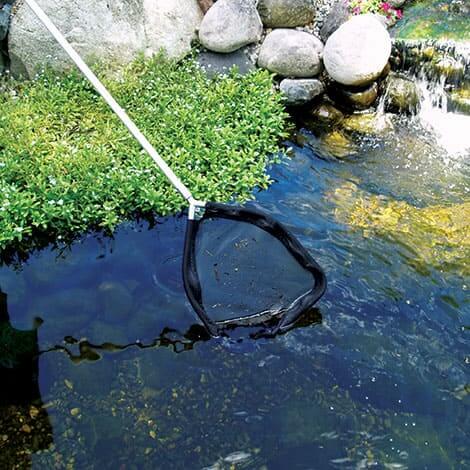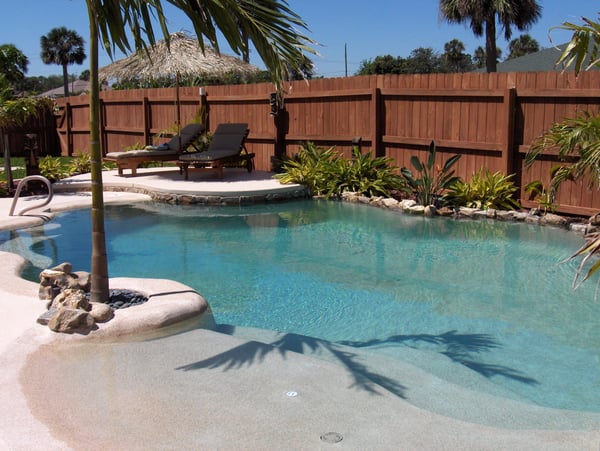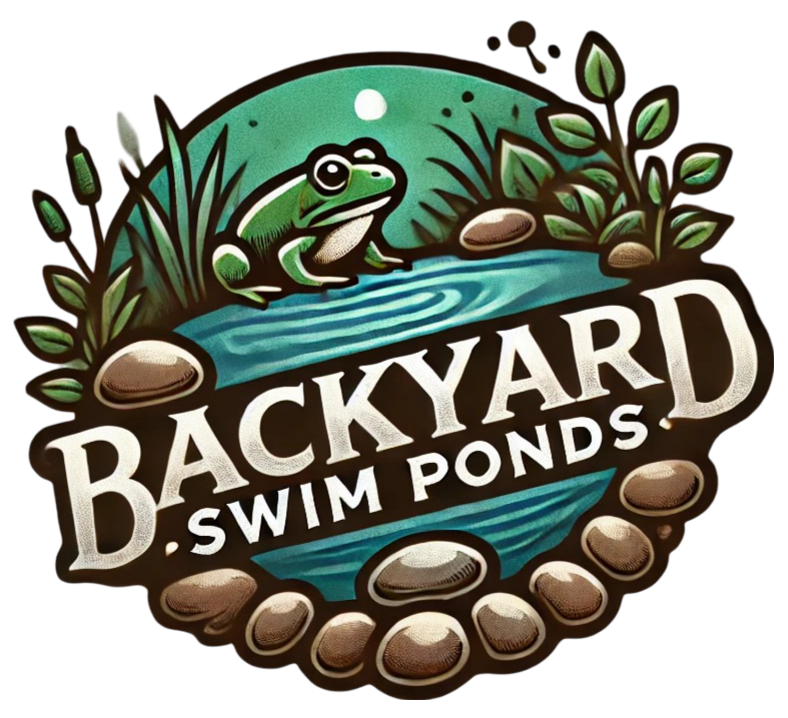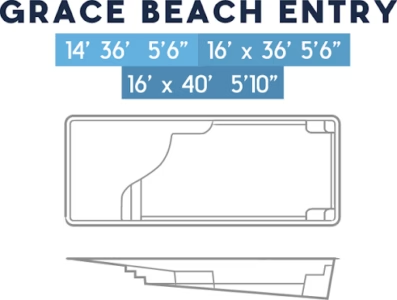Creating a natural beach entry for your swim pond not only enhances its aesthetic appeal but also improves its functionality and accessibility. Picture a gentle slope of soft sand leading into crystal-clear water, inviting family and friends to enjoy summer days filled with swimming and relaxation in a serene outdoor environment. A beach entry seamlessly blends land and water, making it an ideal choice for homeowners seeking a more natural appearance in their yard.
This kind of entry mimics the feel of a lakeside beach, allowing everyone to walk into the water easily without the hassle of ladders or steps. It’s particularly beneficial for families with children and for individuals who may have mobility challenges, as it provides safer access to swimming areas. In addition to promoting family enjoyment, a natural beach entry also enhances the overall landscape by integrating the swim pond into its natural surroundings, while providing a filtration function that helps maintain water quality.
In this guide, you will learn how to effectively create a sandy beach entry that is sustainable, attractive, and easily integrated into your existing swim pond. We will cover essential aspects such as material selection, construction techniques, maintenance strategies, and regulatory requirements, ensuring you have everything you need for a successful project.
How to Create a Safe and Accessible Beach for Everyone
When designing a beach entry, accessibility should be a top priority. Making sure that all users can enjoy your swim pond, regardless of their physical abilities, is not only a good idea, but it’s often a requirement under the Americans with Disabilities Act (ADA).
The slope you choose for your beach entry should be gentle, with a recommended maximum of 1:12, meaning that for every unit of vertical rise, there should be at least 12 units of horizontal distance. This gradual incline makes it easier and safer for children, seniors, and those with mobility challenges to enter the water.
You might also consider adding features like handrails or benches along the beach entry to provide support for users who may need assistance. Additionally, tactile ground surface indicators can help visually impaired individuals navigate the area safely.
By incorporating shallow areas at the entrance, you can further enhance safety, allowing everyone to wade into the water at their own pace. A thoughtful approach to accessibility can transform your swim pond into a welcoming destination for all, encouraging family gatherings and social events.
Diagram of a beach entry showing various sizes and slopes (Source: Thursday Pools)
Choosing the Right Materials for Your Beach Entry
Selecting the right materials for your beach entry is crucial for longevity and visual appeal. Silica sand is a popular choice and preferred for its cleanliness and comfort when walking.
Using silica sand over regular beach sand is advisable because it is dense and falls out of suspension quickly—an important factor for maintaining clear water in your pond. Make sure to aim for a sand depth of at least 6 inches but not exceeding 18 inches.
In addition to sand, other materials such as gravel, river stones, or even concrete can be useful. Gravel offers a more natural appearance and helps prevent erosion, while concrete allows for versatile designs but requires skilled installation for optimal results.
A combination of materials often yields the best outcome. For example, laying geotextile fabric beneath your sand will help prevent it from mixing with the soil below, maintaining the integrity of your beach area.

Different beach entry materials used in swim ponds (Source: Coastal Wiki)
Constructing Your Beach Entry: Step-by-Step Guide
When you’re ready to construct your beach entry, a step-by-step approach is your best bet for success. Start by planning the layout to ensure the beach entry blends seamlessly with your existing swim pond.
-
Excavation: Begin by excavating the designated area for your beach entry. Ensure you maintain a gentle slope ratio of 10:1 (10 feet horizontal for every 1 foot of depth).
-
Install Underlayment: Lay down a geotextile fabric to prevent sand from intermingling with the soil beneath.
-
Sand Layer: Add the silica sand to the designated area, ensuring it meets the minimum and maximum depth guidelines. Compact the sand gently to create an even surface.
-
Barrier Installation: Install barriers such as landscape timbers or concrete curbs along the edges to protect the sand from erosion.
-
Filtration Integration: Adjust your existing filtration system to ensure proper water circulation. You might consider adding a dedicated wetland filter near the entry to promote water clarity.
-
Finishing Touches: Finally, enhance the area with native plants along the waterline and any decorative features, such as seating areas or pathways leading to the entry.
Construction steps involved in creating a beach entry (Source: Oak Island NC)
Maintaining Your Beach Entry: Essential Tips and Tricks
Once your beach entry is complete, regular maintenance is essential for its appearance and functionality. Here are some common challenges and how you can address them:
-
Sand Migration: Over time, sand can shift and create uneven surfaces or expose the underlayment. To minimize this, use barriers to keep the sand in place and maintain a continuous flow of water through the sandy area.
-
Algae Growth: The warm, shallow water of your beach entry may encourage algae. Regular cleaning, along with proper filtration, can help keep it under control. Raking the beach regularly to remove organic material will also be beneficial.
-
Plant Integration: Incorporating native aquatic plants can help stabilize the sand and contribute to a healthy ecosystem. These plants can filter runoff and enhance biodiversity around your pond.
-
Routine Maintenance: Commit to a schedule for routine upkeep, which includes seasonal cleanings and water quality checks. Plan to remove debris, monitor algae, and occasionally flush sand to maintain optimal conditions.

Tools used for maintenance of swim ponds (Source: BigCommerce)
Understanding Regulations and Permits for Your Project
Before beginning construction on your beach entry, it’s important to familiarize yourself with the local regulations and permits that you’ll need. Regulations can vary significantly, particularly for projects involving water features like swim ponds.
-
Permit Requirements: Generally, a beach entry swim pond is treated similarly to traditional pools, requiring permits for construction, electrical installations, and potentially plumbing.
-
Specific Regulations: Local authorities may have specific regulations related to slope ratios. Some municipalities advise an even gentler slope than the recommended 1:12 ratio.
-
Environmental Assessments: In certain areas, you may need an environmental assessment before construction, particularly for larger ponds. This process can take several months, so it’s important to plan ahead.
-
Safety and Setbacks: Many localities require safety barriers around the pond area. Ensure that your designs comply with local zoning regulations regarding setbacks and safety standards.
![]()
Infographic summarizing important rules and regulations (Source: Shutterstock)
Budgeting Your Beach Entry Project: What to Expect
The costs associated with constructing a beach entry can vary widely based on size, materials, and your location. Here’s a breakdown to guide your budgeting process.
-
Cost Estimates: Small beach entries might cost between $3,000 to $7,000, while larger installations could range from $15,000 to $25,000.
-
Factors Influencing Costs: Costs may include excavation, filtration adjustments, and the materials you choose. For example, modifying the existing liner could add between $2,000 and $10,000 to your budget.
-
Permitting and Inspections: Factor in additional expenses for permits, generally in the range of $500 to $2,000.
-
Contingency Plans: Always include a buffer of 10% to 15% in your budget for unexpected costs that may arise.

Chart outlining various cost factors for beach entry projects (Source: River Pools and Spas)
Transformative Beachfront Aesthetics: Adding Finishing Touches
The final elements you choose for your beach entry area can elevate the entire experience. Consider these enhancements:
-
Landscaping: Thoughtfully placed plants enhance both the beauty and ecological benefits of the beach area. Native plants, in particular, help maintain biodiversity.
-
Lighting and Seating: Installing LED lighting along pathways or near seating areas can create an inviting atmosphere in the evenings. Adding comfortable benches or loungers that complement the natural surroundings offers additional appeal.
-
Eco-Friendly Materials: When selecting materials for your beach area, consider sustainable options that harmonize with the natural landscape, improving both aesthetics and environmental impact.
These finishing touches can transform your beach entry into an appealing highlight of your outdoor space, promoting relaxation and enjoyment for all.

Landscaped beachfront entry highlighting aesthetics (Source: HGTV Home)
Conclusion
Creating a natural beach entry for your swim pond is an investment that pays off in beauty, accessibility, and enjoyment. As you embark on this project, thoughtful planning is critical: from choosing the right materials and construction techniques to maintaining the area and following local regulations.
By prioritizing accessibility and considering the ecological impact of your design, you can craft a space that is enjoyable for your family and friends while positively impacting your environment. Embrace the process of creating your beach entry; you’re not just adding a feature to your yard, but you’re also building lasting memories for many summers to come.
With the right approach, your swim pond will become a cherished retreat, offering a blend of natural beauty and functional enjoyment. Have fun with the project, and let your vision come to life!

